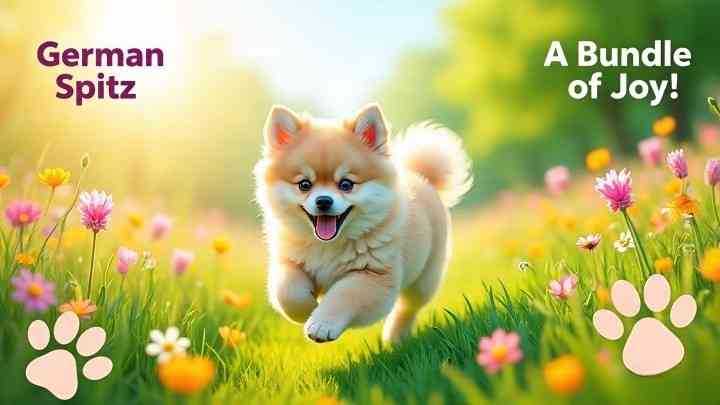
German Spitz is a lively, intelligent and fluffy companion dog known for its fox-like face, thick double coat and playful nature. This small to medium breed is easy to train, loyal to its family and makes an alert watchdog, making it a perfect choice for active homes and first-time pet parents.
Table of Contents
Introduction to the German Spitz
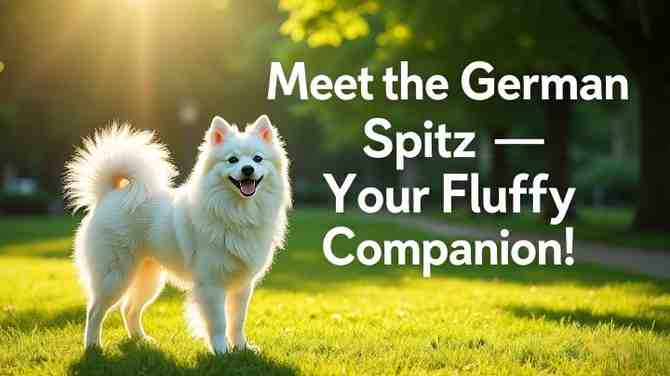
The German Spitz represents a genuine Nordic breed and is easily identifiable by its attention-grabbing double coat, foxy pointed snout, and plume that comfortably curls over its back. The breed is not just one breed, it is actually a breed family that is categorized primarily by size. The German Spitz has been bred for guiding and guarding. The breed is alert, loud, and exceptionally loyal to its family and friends. Under that glamorous outside façade there is a tough, agile, and surprisingly hearty dog.
Why the German Spitz is Loved Worldwide

Now you can see why the German Spitz is a leading breed for owning around the globe. Their size and ease of grooming (grooming, and cleanliness contribute to their popularity) make them a dog that fits into a city lifestyle.They are also quite intelligent and are referred to as “thinking” dogs that enjoy tricks and puzzles. They also possess an intense level of love and loyalty for their owners and take part in most of family life. So, if you are searching for a dog that looks good, is intelligent, and takes part in family life, then the German Spitz adults are a strong candidate!
History and Origin of the German Spitz
Ancient Roots of the German Spitz
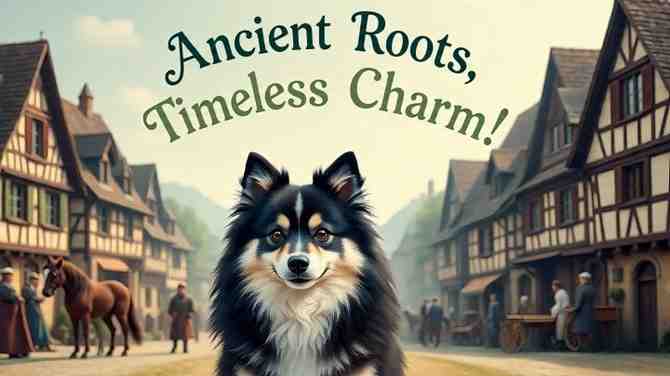
The origins of the German Spitz breed lie in a distant past. They are distant descendant of ancient Nordic herding and hunting dogs, like the Samoyed and the Lapland Herder, which were brought to Northern Europe by Vikings and traders. Fossil remains from the stone age uncovered evidence of a “peat dog” (Torfhunde) look remarkably similar in form those of today’s spitz breeds. The (German) Spitz is among the oldest type of dogs from central Europe.
Evolution of the Breed Through the Centuries
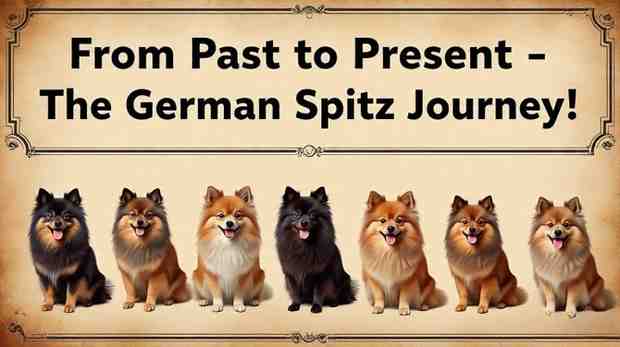
Over centuries, these versatile dogs were adapted for various roles across Germany. Their keen hearing and tendency to bark at anything unusual made them exceptional watchdogs for properties, boats, and farms. Their intelligence saw them employed in herding sheep and even controlling vermin. Selective breeding for specific sizes and traits in different regions led to the development of the distinct varieties we know today
Recognition by Kennel Clubs Around the World

The German Spitz has been known in its country of origin for some time. The Fédération Cynologique Internationale (FCI) considers the breed as being recognized. In the UK, the Kennel Club has been recognized the German Spitz Breed (Klein and Mittel). The American Kennel Club (AKC) does not recognize the breed as a separate breed, but groups the characteristics together within the closely-related “German Spitz” standard or recognizing the Keeshond and Pomeranian as separate breeds.
Different Types of German Spitz Dogs

The breed is officially divided into size variants, each with the same standard aside from height.
Klein (Small) German Spitz

The Klein is the most popular variety outside of Germany. With a height of 9 to 11.5 inches at the shoulder, this small, compact dog is full of energy and character. These dogs are frequently confused with the Pomeranian because they are slightly larger in size with a fox-like, elongated muzzle compared to the Pomeranian’s shorter, “baby-doll” face.
Mittel (Medium) German Spitz
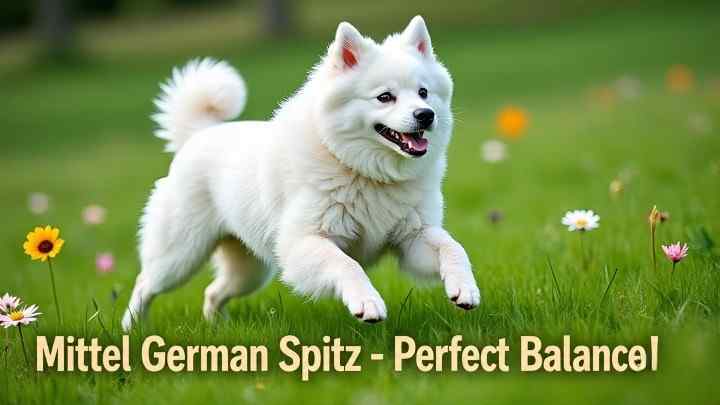
The Mittel is the original and most ancient form of the breed. Standing approximately 12 to 15 inches tall, these are sturdy, medium-sized dogs. They retain all the typical Spitz qualities: a weather-resistant coat, a confident disposition, and alertness. They are extremely popular in Germany and growing in popularity elsewhere because of their sturdier build.
Giant Variants and Related Breeds (Keeshond, Pomeranian)

The Spitz family is extensive. The Giant German Spitz is atypical outside of Germany but an ancestor of the little-appreciated Keeshond (basically a Giant German Spitz in a different wolf-grey and black coat). Conversely, the Pomeranian was bred down from the Klein German Spitz to be the little fluffy toy most people know today. They all have the same general conformation, coat, and smart, alert disposition.
Physical Characteristics of the German Spitz
Size, Weight, and Coat Colors

| Variety | Size (Height at Shoulder) | Weight Range | Common Coat Colors | Brief Explanation |
|---|---|---|---|---|
| Wolfspitz / Keeshond (Largest) | 43–55 cm (17–22 in) | 25–30 kg (55–66 lbs) | Grey-shaded, silver-grey with black tips | This is the biggest type, known for its fox-like face and thick double coat. Often called Keeshond outside Germany. |
| Giant Spitz (Großspitz) | 42–50 cm (16–20 in) | 15–23 kg (33–50 lbs) | White, black, or brown | A large but agile spitz, traditionally used as a guard dog on farms. |
| Medium Spitz (Mittelspitz) | 30–38 cm (12–15 in) | 7–11 kg (15–24 lbs) | White, black, brown, orange, grey-shaded | The most common size; lively and alert, making a great family pet. |
| Small Spitz (Kleinspitz) | 23–29 cm (9–11.5 in) | 3–5 kg (6–11 lbs) | White, black, brown, orange, cream, grey-shaded | Compact and playful; fits well in apartments and easy to carry. |
| Pomeranian (Zwergspitz / Toy Spitz) | 18–22 cm (7–8.5 in) | 1.8–3.5 kg (4–7 lbs) | Wide range: orange, cream, black, white, blue, sable | The tiniest version, famous for its fluffy coat and bold personality. It’s registered separately in some countries but belongs to the same German Spitz family. |
Unique Appearance and Double Coat

The German Spitz is all about the coat. They possess a magnificent double coat: a soft, dense, woolly undercoat for insulation and a long, straight, harsh-textured outer coat that stands off from the body. This combination creates their iconic “mane” around the neck and well-feathered trousers on the hind legs. Their head is fox-like with alert, dark eyes and small, pointed ears that are always erect
Comparing the German Spitz to Similar Breeds
People often confuse the Klein German Spitz with the Pomeranian. The key differences are size and proportion. Poms are significantly smaller (3-7 lbs) and have a shorter muzzle. The German Spitz is also often compared to the American Eskimo Dog, which is a North American breed developed from the German Spitz.
| Breed | Origin | Size & Weight | Coat & Colors | Temperament in Brief |
|---|---|---|---|---|
| German Spitz (Mittel/Klein) | Germany | Medium to small; 23–38 cm (9–15 in), 3–11 kg (6–24 lbs) | Thick double coat; white, black, brown, orange, grey-shaded | Alert, lively, family-friendly, moderate watchdog instincts |
| Pomeranian (Zwergspitz) | Germany/Poland | Toy; 18–22 cm (7–8.5 in), 1.8–3.5 kg (4–7 lbs) | Very fluffy coat; many colors (orange, cream, black, etc.) | Bold, energetic, loves attention, great lap dog |
| Keeshond (Wolfspitz) | Netherlands/Germany | Large; 43–55 cm (17–22 in), 25–30 kg (55–66 lbs) | Silver-grey with black tips, thick ruff | Gentle, affectionate, friendly with strangers, family companion |
| American Eskimo Dog | USA (descended from German Spitz) | Small to medium; 23–48 cm (9–19 in), 3–16 kg (6–35 lbs) | Pure white or cream, fluffy double coat | Smart, playful, good with kids, trainable |
| Finnish Spitz | Finland | Medium; 39–50 cm (15–20 in), 7–14 kg (15–30 lbs) | Golden-red coat, straight and dense | Very vocal, alert hunter of small game, affectionate with owners |
| Samoyed | Siberia/Russia | Large; 48–60 cm (19–24 in), 16–30 kg (35–65 lbs) | Thick white “smiling” coat | Friendly, gentle, strong working dog, minimal guarding instincts |
Temperament and Personality of the German Spitz
Typical Behavior and Energy Levels

The German Spitz may look beautiful, but is a working dog at heart. They are smart, curious, and have what seems to be an innately boundless reservoir of energy to play with. They are quite vocal, thus making excellent watchdogs, as they will tell you of any visitors, a leaf passing by, or a squirrel in the yard. While they are not typically hyper, they do need daily mental and physical activity/stimulation to be happy.
Are German Spitz Dogs Good for Families?

Absolutely. A well-socialized German Spitz is a wonderful family dog. They are fun-loving and loving with kids; however, as with all dogs, it is best to observe any interaction with very young children. Being small, they can easily be injured accidentally and can be damaged by being treated roughly. They do well within families, where they can take part in pack life as one of the “central members.”
Socializing the German Spitz with Other Pets

Socialization is critical for this breed. With proper socialization at a young age, a German Spitz can be cohabitate well with other dogs and, sometimes with cats. However, their high prey drive may cause them to see small creatures, like pet birds or hamsters, as prey, not pets. One additional factor may be their herding instincts might want to herd the other pets in the home.
Caring for a German Spitz
Daily Exercise and Playtime Needs

This is not a couch potato breed. A German Spitz requires at least 30-60 minutes of exercise daily. This can be broken into two brisk walks and sessions of fetch or puzzle games in the yard. They excel in dog sports like agility, rally, and obedience, which provide excellent mental and physical outlets.
Feeding and Nutrition Tips for German Spitz Dogs

As an active small breed, they do best on high-quality dog food formulated for their size and energy level. Be vigilant about portion control; their small stature means even a little extra weight can put stress on their joints. I recommend measuring meals and limiting treats. A healthy diet also promotes skin and coat health.
Grooming and Coat Maintenance Guide

This is a commitment. That gorgeous coat requires thorough brushing 2-3 times per week with a pin brush and undercoat rake to prevent mats and remove loose hair. During their biannual “blow” of the undercoat (which can be impressive), daily brushing is essential.
How to Handle Shedding and Matting

Brushing regularly is the only way to stay on top of shedding and to prevent mats. Pay extra special attention to areas that are prone to friction, such as behind the ears, underneath the legs, and around the trousers. Bathing every 4-6 weeks with a quality conditioner makes daily brushing easier. You should never shave a German Spitz because their double coat is essential for temperature regulation.
Training Your German Spitz
Basic Training Commands for Beginners
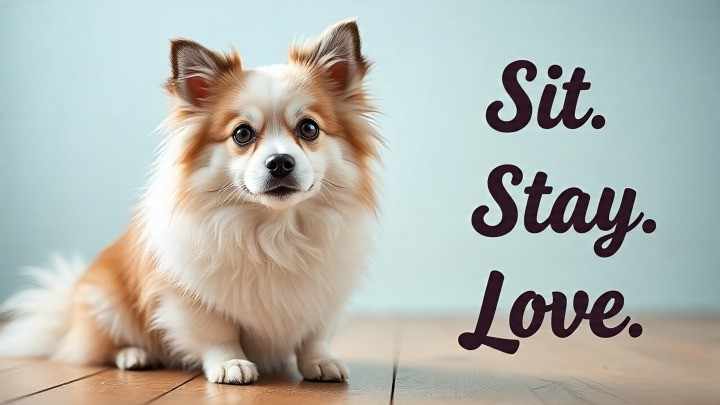
Their intelligence makes them eager to learn, but they can also be independent. Start with short, fun, and positive sessions. Essential commands include:
- Sit & Stay: For impulse control.
- Come: A reliable recall is vital for safety.
- Leave It: To curb their curiosity.
Potty Training Tips for Puppies

Consistency is key. Take your puppy out first thing in the morning, after meals, after naps, and before bed. Use a specific command and lavish them with praise and a treat when they succeed. Crate training is highly effective as it discourages them from soiling their sleeping area.
Positive Reinforcement vs. Discipline
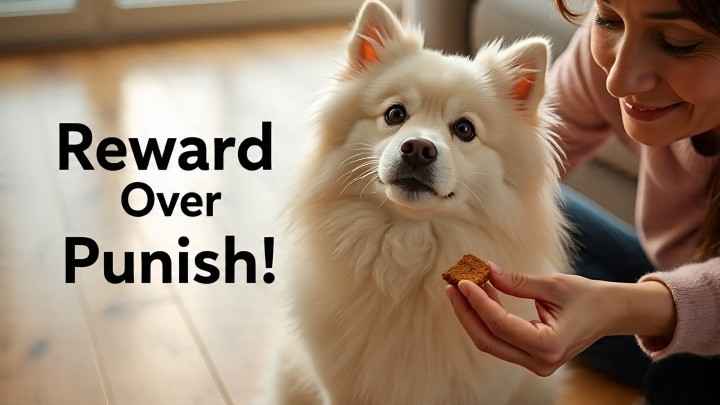
This dog is a sensitive soul who does not respond well to harsh discipline. It will break their trust and can lead to fear-based behaviors like submissive urination or anxiety. Positive reinforcement—using treats, praise, and play as rewards—is the only effective method. They aim to please and will work hard for a reward.
How to Reduce Barking and Unwanted Behaviors

Since barking is a natural instinct, your goal is management, not elimination. Teach a “quiet” command by rewarding moments of silence. Provide plenty of exercise and mental stimulation to curb boredom barking. Manage their environment by blocking their view of the street if that is a trigger.
Common Health Issues in German Spitz Dogs
Genetic Conditions to Watch Out For

Thankfully, it is a generally healthy and robust breed. However, like all purebred dogs, they have some predispositions. Reputable breeders test for these:
- Patellar Luxation: A dislocating kneecap, common in small breeds.
- Hip Dysplasia: A malformation of the hip joint (more common in Mittel).
- Eye Conditions: Progressive Retinal Atrophy (PRA) and cataracts can occur.
- Skin Allergies: Some lines can be prone to skin irritations.
Regular Vet Checkups and Vaccinations

Routine veterinary care is the cornerstone of a long, healthy life. This includes annual check-ups, keeping up-to-date on vaccinations, and regular parasite control (fleas, ticks, heartworm). Your vet can also monitor your dog’s dental health, which is crucial for small breeds prone to periodontal disease.
Lifespan and How to Keep Them Healthy Longer

This is a long-lived breed, with a typical lifespan of 13-15 years, and many live even longer. The keys to longevity are simple: a high-quality diet, maintaining a healthy weight, regular exercise, proactive veterinary care, and plenty of love and mental engagement.
Living with a German Spitz
Is the German Spitz Good for Apartment Living?

Incredibly so. Their diminutive stature and moderate exercise requirements make them great for an apartment or condo setting. You will want to work on their barking though, if you plan to love your neighbors. A window perch (for their spying needs!) and plenty of indoor play will surely keep them happy.
Travel Tips with a German Spitz Dog

Their size makes them excellent travel companions. Always use a secure, crash-tested travel crate or a canine seatbelt harness in the car. Never leave them alone in a parked car. For longer trips, ensure they have familiar bedding, toys, and access to fresh water.
How to Introduce Your German Spitz to New Environments

Due to their nature, Spitz breeds may have a more reserved temperament. Faciliate your dog’s comfort in a new place by allowing for small doses in a long time frame. Start with your dog observing at a distance while using higher value treats to develop a connection of positiveness a the focus or attention is on you and the tasty treat. Most importantly, allow and do-not force a spitz into an overwhelming experience.
How to Choose a German Spitz Puppy
Finding a Reputable Breeder

This is the most critical step. A good breeder:
- Prioritizes health testing and can show you OFA/PennHIP certificates for hips, patellas, and eye clearances.
- Is knowledgeable about the breed’s genetics and history.
- Raises puppies in their home, not in an isolated kennel.
- Asks you numerous questions to ensure you’re a good fit.
- Welcomes you to meet the puppy’s parents.
Adoption vs. Buying from Breeders
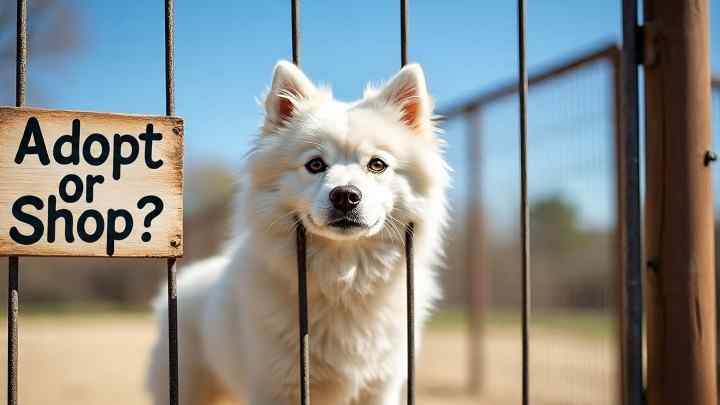
While purchasing from a reputable breeder is common, adoption is a wonderful option. Breed-specific rescues do exist for Spitz-type dogs. Check organizations like Spitz Rescue or general small breed rescues. You may have to be patient, but giving a home to a dog in need is incredibly rewarding.
What to Look for in a Healthy German Spitz Puppy

A healthy puppy will have bright eyes, will be curious, playful, and full of energy. The coat, eyes, and ears of a puppy should be clean and healthy, and the puppy should not be lame. A puppy should be confident and not too shy or aggressive, watch the whole litter and how they act with their mom.
Conclusion – Why the German Spitz Might Be Your Perfect Companion

This is not simply a good-looking dog breed. They provide you with a bundle of intelligence, loyalty, and energy all covered in a stunning coat. They will bring out the best in you as an active and involved dog owner and return your efforts with endless love and amusement. If you would like an intelligent dog that is active and a family member and companion, the German Spitz may exactly the dog for you. Please do your research, purchase a good one, and be prepared to be chanted by one of dogdom’s most delightful dog breeds.
